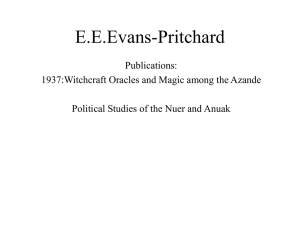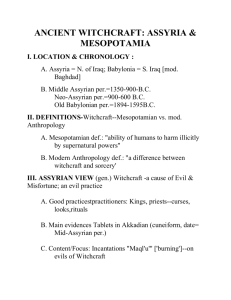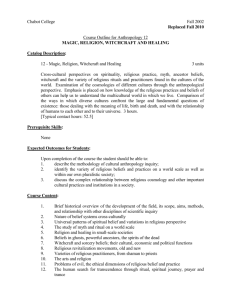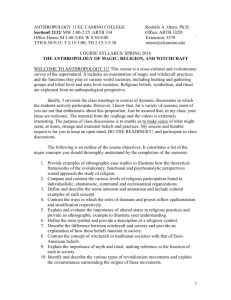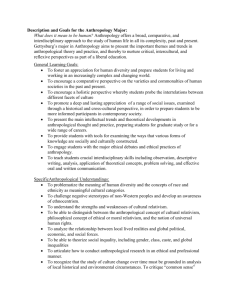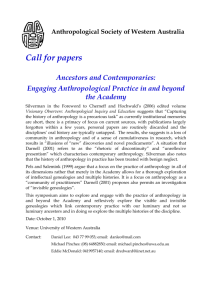SOAN 256 F09 PFS Africa syllabus
advertisement
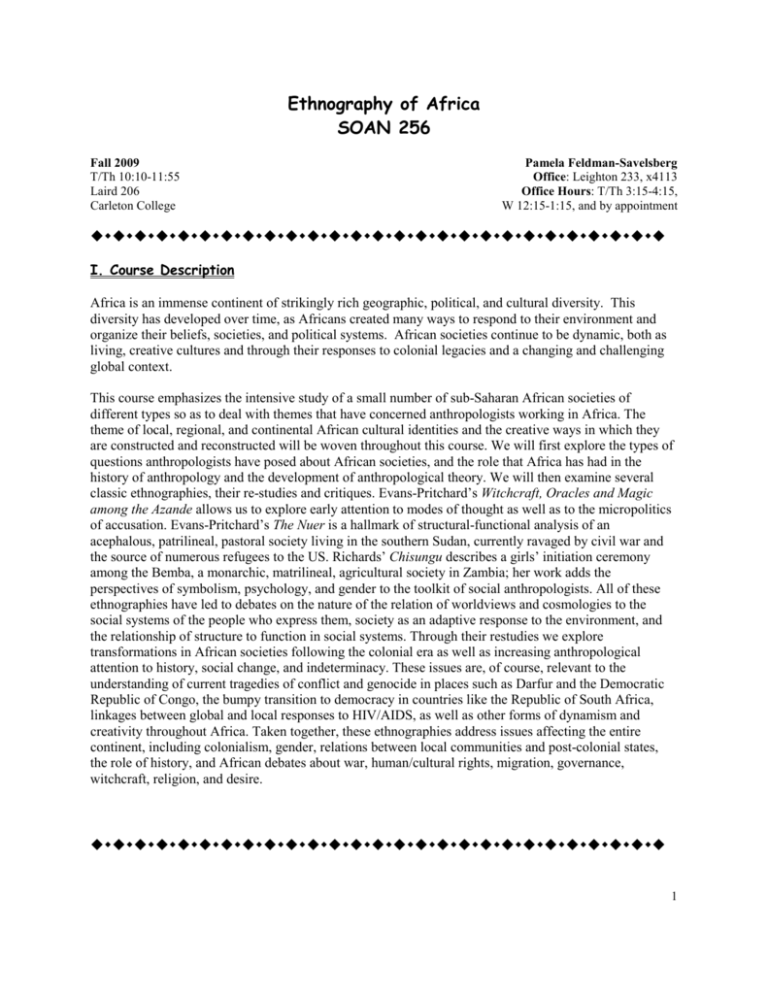
Ethnography of Africa SOAN 256 Fall 2009 T/Th 10:10-11:55 Laird 206 Carleton College Pamela Feldman-Savelsberg Office: Leighton 233, x4113 Office Hours: T/Th 3:15-4:15, W 12:15-1:15, and by appointment I. Course Description Africa is an immense continent of strikingly rich geographic, political, and cultural diversity. This diversity has developed over time, as Africans created many ways to respond to their environment and organize their beliefs, societies, and political systems. African societies continue to be dynamic, both as living, creative cultures and through their responses to colonial legacies and a changing and challenging global context. This course emphasizes the intensive study of a small number of sub-Saharan African societies of different types so as to deal with themes that have concerned anthropologists working in Africa. The theme of local, regional, and continental African cultural identities and the creative ways in which they are constructed and reconstructed will be woven throughout this course. We will first explore the types of questions anthropologists have posed about African societies, and the role that Africa has had in the history of anthropology and the development of anthropological theory. We will then examine several classic ethnographies, their re-studies and critiques. Evans-Pritchard’s Witchcraft, Oracles and Magic among the Azande allows us to explore early attention to modes of thought as well as to the micropolitics of accusation. Evans-Pritchard’s The Nuer is a hallmark of structural-functional analysis of an acephalous, patrilineal, pastoral society living in the southern Sudan, currently ravaged by civil war and the source of numerous refugees to the US. Richards’ Chisungu describes a girls’ initiation ceremony among the Bemba, a monarchic, matrilineal, agricultural society in Zambia; her work adds the perspectives of symbolism, psychology, and gender to the toolkit of social anthropologists. All of these ethnographies have led to debates on the nature of the relation of worldviews and cosmologies to the social systems of the people who express them, society as an adaptive response to the environment, and the relationship of structure to function in social systems. Through their restudies we explore transformations in African societies following the colonial era as well as increasing anthropological attention to history, social change, and indeterminacy. These issues are, of course, relevant to the understanding of current tragedies of conflict and genocide in places such as Darfur and the Democratic Republic of Congo, the bumpy transition to democracy in countries like the Republic of South Africa, linkages between global and local responses to HIV/AIDS, as well as other forms of dynamism and creativity throughout Africa. Taken together, these ethnographies address issues affecting the entire continent, including colonialism, gender, relations between local communities and post-colonial states, the role of history, and African debates about war, human/cultural rights, migration, governance, witchcraft, religion, and desire. 1 II. Course Requirements A. Required Reading Readings should be completed before the class session for which they are assigned. Readings consist of book length ethnographic monographs (available in the bookstore), and scholarly articles. All articles are on reserve either electronically (e-reserves, password SOAN) or as hard copies in the library. Required texts (available in the bookstore) are as follows: A. Ashforth, Witchcraft, Violence, and Democracy in South Africa E.E. Evans-Pritchard, The Nuer E.E. Evans-Pritchard, Witchcraft, Oracles, and Magic Among the Azande S. Hutchinson, Nuer Dilemmas: Coping with Money, War, and the State S.F. Moore, Anthropology and Africa A.I. Richards, Chisungu D. Shandy, Nuer-American Passages: Globalizing Sudanese Migration B. Class Participation (10% of grade) This class combines lecture and discussion of readings, films or slides, and concepts. The second half of (mostly) Thursday sessions are your days; discussion will be student led. Student participation in all discussions is essential both for your own learning and for that of the other students in class. This requires that you have read and thought about the readings for the day, and that you listen carefully when other students ask questions or propose a new or different way to think about the materials we are studying. When we enter the classroom, we should learn from our readings and from each other through courteous, constructive debate. Class attendance is considered part of class participation, and frequent absences will lower your grade. As a courtesy, please warn me of impending absences or tell me why you were absent as soon as you can. Make friends with classmates to share notes in case of absences, or if you feel you didn’t fully understand something. More importantly, ask questions, call me, or come to my office hours if anything is unclear to you or if you want to discuss something related to this class. In grading class participation, I will take into consideration class attendance, and most importantly, discussing readings and issues in a thoughtful and prepared way. C. Short Response Papers (5% each; 20% of grade total) Each student is required to write four 1to 2 page response papers due at the beginning of class (with sign up). Your intellectual engagement with the text(s) of the day is paramount. I will look for your intellectual reactions to specific points and/or general analyses, your use of evidence, and your observations on how these readings have confirmed, augmented, or challenged your prior assumptions and experiences. You cannot do everything in one to two pages, so pick a point that particularly moves you and work with it. Please remember to cite your sources, using anthropological citation style. You must hand in all four assignments to get credit for short response papers. D. Media/current events presentation (10% of grade) This is a group assignment to be done in pairs or, depending on course enrollment, in small groups of three. For this 10-minute (max!) presentation, you should: 1) select a current news topic about Africa based upon a substantial article from a major US, British, or French newspaper or news magazine; 2) clearly state what the topic is and how it isr epresented; 3) based upon your own library research, what background information is crucial to our understanding? 4) Then, using on-line African newspaper sources, present how your topic is represented and/or debated within a specific African country. French and Francophone Studies concentrators should use articles from French language print media, such as Le Monde, Le Monde Diplomatique, or Jeune Afrique, and on-line newspapers from francophone African countries. In addition to your 10 minute (max!) oral presentation, you should also create a handout with a copy of one or two of your newspaper clipping (including its URL for web access), and a brief bibliography of relevant, 2 anthropological work that would provide further background. Your presentation should let each group member shine, and should reflect the division of labor in the preparation of the assignment. Current events presentations will occur at the beginning of selected class sessions. You will sign up for a due date. By the end of the term, we will all have a nice collection of news clippings and bibliographies, and a better grasp of African affairs. Use this assignment to stretch your mind about the uses and relevance of African ethnography. E. Leading Class Discussion (20% of grade) You, as an individual or as part of a team, will be responsible for leading class discussion on one week’s set of readings. Leading class discussion has a number of components. You should develop a set of discussion questions (no more than three) that draw out the theoretical and comparative significance of the week’s readings. Feel free to experiment with format, including debates, cases, or role plays. You should develop a prompt or reflection question to distribute via e-mail NO LATER THAN 5:00 p.m. the day before your discussion session. This could be one of the questions you plan to discuss in class, or it could be a request for preparation (e.g. select a favorite quotation that illustrates x, y, or z). You should also read one extra anthropological article related to the week’s topic, and (together) prepare a ten minute (not longer!) presentation discussing this article and its relation to the week’s readings and to your questions. The short presentations and discussions together last for half a class period. On the day of your presentation/discussion leading, you should hand in to me a copy of your discussion questions and the bibliographic reference of your supplemental article. Please also bring copies to class for your classmates. I encourage and expect teams of discussants to cooperate and coordinate their discussion leading. Discussion leaders are required to meet with me during Wednesday office hours or by special appointment (e.g. on Monday preceding Tuesday discussion sessions). If you are part of a team, it is expected that the entire team will meet with me unless scheduling makes this absolutely impossible. A first draft of your discussion questions and your search for a supplementary article should be completed for this meeting. We will use the meetings to discuss the topic, refine the questions, and consider discussion-leading strategies. A sign-up sheet will be posted on my office door, and passed around on the second day of class. F. Final Term Paper (40% of grade [10% proposal and bibliography, 25% final paper, 5% oral presentation]) The final assignment is a ten-page library research paper and oral presentation. For presentations, we will organize the paper presentations into panels. Each student should choose a topic area by Tuesday October 6. You will then hand in a brief (up to one page) but thorough proposal of your specific topic plus a one- page bibliography of relevant sources on Thursday October 15. (This lets you get your proposal done before midterm break!) Oral presentations will occur on November 17. The written papers are due on Wednesday November 18, 3:00 p.m. Please cite your sources using anthropological citation style. G. Writing Portfolio If you are a first or second year student, you may find one or more of the writing assignments in this course to be appropriate for your writing portfolio, which is due at the end of your sixth term. Please talk with me about authenticating your work while this course is underway. I will work with you to revise, if necessary, and I will sign an authentication form that you prepare. If you want to use a final paper or project for your portfolio, I will need an authentication form and a stamped, self-addressed envelope to return your work to you. For more information on the portfolio, consult the folder you received as a first-year student, talk with your advisor, or read about it on the web at: http://www.acad.carleton.edu/campus/wp/ H. Assumptions I assume and expect: • That we will all be enthusiastic and respectful participants in class. • That you will let me know (ahead of time whenever possible) if you need to be absent and why. • That you will follow rules of academic honesty (i.e. cite correctly and do not plagiarize). • That you will follow anthropological citation style in any written work. 3 • • • That if you have a disability that affects your ability to participate fully in class or to meet all course requirements that you will tell me at the beginning of the term so that appropriate accommodations can be arranged. That if you have any other concerns needing special consideration (e.g. weak anthropology background, not a native speaker of English, special family circumstances), that you will also bring this to my attention early in term. That you will hand in assignments and be prepared for oral presentations on time. Deadlines are deadlines, including presentations for which you have signed up. Nonetheless, if you talk to me before the due date about extenuating circumstances, I am not an ogre and will accommodate your needs within the realm of fairness. Departmental policy is to subtract one letter grade per assignment for each day an assignment is late. III. The Term at a Glance A. Topics Part One: Themes in the Anthropology of Africa Part Two: Classic Ethnographies and their Restudies Witchcraft, Oracles and Magic among the Azande (Sudan/Congo) “Restudy” of Witchcraft: Modernity and Poverty in the Wake of Apartheid (South Africa) The Nuer (Sudan) “Restudy” of the Nuer I: the longue durée and current civil war “Restudy” of the Nuer II: refugees, globalization, and continuing links to “home” Chisungu (the Bemba, Zambia) “Restudies” on Initiation in Modern Times (the Bemba, Zambia; the Busoga, Uganda) Part Three: Contemporary Issues in the Anthropology of Africa: Student Presentations B. Due Dates October 6: Topic choice due October 15: Term paper proposals and bibliographies due November 17: Paper presentations November 18: Final term papers due, 3:00 p.m. Throughout the term: Short response papers, discussion leading, current events presentations C. Grading Class participation Short response papers (all 4) Current Events presentation Leading class discussion Term paper proposals Final term paper Oral presentation of term paper 10% 20% 10% 20% 10% 25% 5% IV. Resources The following resources are either on reserve in the library, or can be found in the reference section. Readers and Collected Essays Grinker, R.R. and C.B. Steiner, eds. 1997. Perspectives on Africa: A Reader in Culture, History, and Representation. Oxford: Blackwell. Martin, P. and P. O'Meara, eds. 1995. Africa. (3rd Edition) Bloomington: Indiana University Press. Mazrui, A.A. 1986. The Africans. Mazrui, A.A. and T.K. Levine, eds. 1986. The Africans: A Reader. New York: Praeger. 4 Encyclopedias, Almanacs, and Bibliographies Middleton, J. and A. Rassam, eds. 1995. Encyclopedia of World Cultures, Vol. 9, Africa and the Middle East. Boston: G.K. Hall. (Ref. GN550 .E53 1991 v.9) Middleton, J., ed. 1997. Encyclopedia of Sub-Saharan Africa. (DT 351.E53 1997 v. 1-4) Encyclopedia of Sex and Gender (Ref. HQ16.E53 2003 v. 1-2) Europa World Yearbook. (Ref. JN1 .E85) Africa Bibliography. (International African Institute) (Ref. DT3.A38) International African Bibliography (Ref. DT3.I58) V. Anthropological Citation Style and Paper Format Paper Format Your papers should include 1) a title page, 2) the 10-page text of your paper, printed double spaced, 12 pt. font, 1 inch margins, 3) references cited, in anthropological citation style (the bibliography of all sources you cited in your paper). Anthropological Citation Style In papers for this and other anthropology classes, you should use the correct citation style, following the major professional journals, American Anthropologist and American Ethnologist. This means you need to cite, both in the text and in a section titled “References Cited” following the text, works from which you have drawn ideas as well as works you quote. In the course of your text, you should cite authors whose ideas you use with their last name and the date of publication, and can even include more than one citation if you got the idea from more than one source (Ginsburg 1989; Ginsburg and Rapp 1991). If you quote an author, e.g. that "the powers of village women... [do not] provide women with the last word," (Harding 1975:308), you must include the page number(s). Note the placement of punctuation, and that the citation and period/comma are outside of the quotation marks. References Cited (not “Bibliography”), placed starting on a new page at the end of your text, does not include any publication not cited in the text. All entries must be listed alphabetically by last name of author, and chronologically arranged for two or more titles by the same author. Nothing, except “in,” is underlined in References Cited. The layout should be as follows: 1) for a journal article, showing the volume and issue numbers, and page numbers: Becker, Gay. 1994 Metaphors in disrupted lives. Medical Anthropology Quarterly 8(4):383-410. 2) for an article in a book of collected essays (Except for first words and proper nouns, article title is lower case, book title is capitalized): Harding, Susan. 1975 Women and words in a Spanish village. In Toward an Anthropology of Women. Rayna R. Reiter, ed. Pp.283-308. New York: Monthly Review Press. 3) for a book (title is capitalized; date, place of publication [use the first one listed], and publisher all included): Riedmann, Agnes. 1993 Science That Colonizes: A Critique of Fertility Studies in Africa. Philadelphia: Temple University Press. 4) for articles taken from the internet, cite as closely as you can to a printed publication (including author’s name, date of publication, title, publisher), followed by the URL of the site you are citing: United Nations. 2009 Revision of the World Population Estimates and Projections. Http://www.popin.org. Following this style is a requirement. More details @ SOAN website: http://apps.carleton.edu/curricular/soan/resources/citation/, for American Ethnologist style. An even more complete guide is available from the American Anthropological Association: http://www.aaanet.org/publications/style_guide.pdf. Reference style is on pp. 10-14 of the AAA document. Ask if you have questions. 5 Course Schedule Part One: Themes in the Anthropology of Africa WEEK I T 9-15 INTRODUCTION Th 9-17 AFRICA AND ANTHROPOLOGY: KEY QUESTIONS AND MULTIPLE HERITAGES S.F. Moore (1994), Anthropology and Africa: Changing Perspectives on a Changing Scene, skim pp. 1-18; read pp. 18-73. WEEK II T 9-22 AFRICA AND ANTHROPOLOGY: AFRICAN INDEPENDENCE AND RECENT WORK S.F. Moore (1994), Anthropology and Africa: Changing Perspectives on a Changing Scene, read pp. 74-133. [Recommended: J. Middleton (1995), "Introduction to Africa," In J. Middleton and A. Rassam, eds. Encyclopedia of World Cultures, Volume IX: Africa and the Middle East, pp. xxiii-xxxiv. Boston: G.K. Hall. Webster (1991), "Abafazi Bathonga Bafihlakala: Ethnicity and Gender in a KwaZulu Border Community," African Studies (Johannesburg) 50(1 and 2):243-271.] Th 9-24 Guest speaker: Kristin Partlo, Social Science Librarian (Professor attending Society for Medical Anthropology 50th Anniversary Conference) Start reading Evans-Pritchard, Witchcraft, Oracles and Magic. Film: Strange Beliefs (1st half is on Evans-Pritchard’s Witchcraft, Oracles and Magic) Part Two: Classics and Their Restudies WEEK III WITCHCRAFT, ORACLES AND MAGIC, AN ANTHROPOLOGICAL CLASSIC III: MODES OF THOUGHT AND MICROPOLITICS T 9-29 E.E. Evans-Pritchard, Witchcraft, Oracles, and Magic among the Azande. Introduction through p. 119. Th 10-1 E.E. Evans-Pritchard, Witchcraft, Oracles, and Magic among the Azande. Pp. 120225. [Recommended: Nadel, S.F. (1982 [orig 1952]) Witchcraft in Four African Societies. In M. Marwick, ed. Witchcraft and Sorcery, pp. 286-299. Harmondsworth: Penguin. Ardener, E. (1970) Witchcraft, Economics, and the Continuity of Belief. In M. Douglas, ed. Witchcraft Confessions and Accusations, pp. 141-160. London: Tavistock. Parkin, D. (1968) Medicines and Men of Influence. Man (N.S.) 3:424-439. J. Comaroff and J.L. Comaroff, Eds. (1993) Modernity And Its Malcontents. Chicago: University of Chicago Press. Comaroff, J. and J.L. Comaroff (1999) Occult Economies and the Violence of Abstraction: Notes from the South African Postcolony. American Ethnologist 26(2):279-303. Meyer, B. (1998) The Power of Money: Politics, Occult Forces, and Pentecostalism in Ghana. African Studies Review 41(3):69-92.] WEEK IV T 10-6 WOM RESTUDIED: MODERNITY, POVERTY AND WITCHCRAFT IN THE WAKE OF APARTHEID, REPUBLIC OF SOUTH AFRICA A. Ashforth (2005) Witchcraft, Violence, and Democracy in South Africa. Chicago: University of Chicago Press. (pp. 1-130). Film: Africa: Search for Common Ground: The Hunt for Witches (South Africa) 6 Th 10-8 A. Ashforth (2005) Witchcraft, Violence, and Democracy in South Africa. (pp. 133-239, 270-278 [on the TRC as witch hunt], and 311-318 [Epilogue]). [Recommended: A “classic”anthropological author on witchcraft in South Africa, and work by her economist son on South African poverty: M. H. Wilson (1936) Reaction to Conquest: Effects of Contact with Europeans on the Pondo of South Africa. (Part II. An Urban Community, Introduction and Chapter XIII Religious and Magical Beliefs, pp. 434-438 and 487-504; Part III. Bantu on European Farms, Introduction and Chapter XVI, pp. 505508 and 536-543) M.H. Wilson (1951) Witch Beliefs and Social Structure. American Journal of Sociology 56(4):307-313. F. Wilson (2006) Monica Hunter Wilson: An Appreciation. Unpublished manuscript, preface to new edition of M. Wilson, Reaction to Conquest. (20 pp). F. Wilson and M. Ramphele (1989) Uprooting Poverty: The South African Challenge. New York: WW Norton (Chapter 9, “Who Are Vulnerable?” pp. 169-185 and Chapter 11, “Apartheid’s Assault on the Poor,” pp. 203-230) More works by Adam Ashforth: A. Ashforth (2000) Madumo, a Man Bewitched. Chcago: University of Chicago Press. A. Ashforth (1998) Reflections on Spiritual Insecurity in a Modern African City (Soweto) African Studies Review 41(3):39-67. A. Ashforth (1999) The Soweto Witch Project. Transition 81/2:22-51. A. Ashforth (2002) An Epidemic of Witchcraft? The Implications of AIDS for the Post-Apartheid State. African Studies 61(1): 121-143. Other contemporary works on witchcraft in post-Apartheid South Africa: I.A. Niehaus, E. Mohlala, and K. Shokane (2001) Witchcraft, Power, and Politics: Explaining the Occult in the South African Lowveld. J. Comaroff and J.L. Comaroff, Eds. (1993) Modernity And Its Malcontents. Chicago: University of Chicago Press. Comaroff, J. and J.L. Comaroff (1999) Occult Economies and the Violence of Abstraction: Notes from the South African Postcolony. American Ethnologist 26(2):279-303. For more works on witchcraft and modernity in West Africa, see books and articles by: Peter Geschiere (1997), Harry West, Birgit Meyer (1999), collections by H. Moore and T. Sanders, eds. (2001) and by H. West and T. Sanders, ed. (2003), and a classic by Edwin Ardener] WEEK V T 10-13 Th 10-15 WEEK VI T 10-20 Th 10-22 THE NUER, AN ANTHROPOLOGICAL CLASSIC I: LAND, LINEAGE, AND IDENTITY E.E. Evans-Pritchard (1940), The Nuer (through page 138) E.E. Evans-Pritchard (1940), The Nuer (finish reading) Film: The Nuer (first half) THE NUER RESTUDIED I: STEREOTYPES, MONEY, AND WAR S. Hutchinson (1996) Nuer Dilemmas (through page 102, including Prologue) **Topic choice due** Film: The Nuer (second half) S. Hutchinson (1996) Nuer Dilemmas (Chapters 4, 6, and Afterword) S. Hutchinson. (2005) Perverse Outcomes: How an International Human Rights Monitoring Mission in Sudan Inadvertently Contributed to the Perpetuation of Military Violence Against Civilians. Unpublished MS. [Recommended further sources: D.H. Johnson (1989). "Political ecology in the Upper Nile:...," Journal of African History 30(3):463-486. D.H. Johnson (1981). "The fighting Nuer: Primary sources and the origins of a stereotype," Africa 51:508-527. M.E. Meeker (1989). "The Nuer warrior identity and segmentary principle" in Meeker, The Pastoral Son and the Spirit of Patriarchy: Religion, Society, and Person among East African Stockkeepers J.J. de Wolf (1990). "Ecology and conquest," Ethnology 29(4):341-363. Kelly, Raymond C. (1985). The Nuer Conquest: The Structure and Development of an Expansionist System. Ann Arbor: University of Michigan Press. 7 T.M.S. Evens (1989). "The Nuer incest prohibition and the nature of kinship: alterlogical reckoning," Cultural Anthropology 4(4):323-346. T.M.S. Evens (1985). "The paradox of Nuer feud and the leopard skin chief: a `creative' solution to the prisoner's dilemma," American Ethnologist 12(1):84-102. A. Free (1988). "Conceptions of power and Evans-Pritchard's ethnography," Edinburgh Anthropology 2:105-139. J. Hutnyk (1990). "Comparative anthropology and Evans-Pritchard's Nuer photography," Critique of Anthropology 10(1):81-102. And, more by Hutchinson herself on Nuer ethnography... S. Hutchinson (1992). "The Cattle of Money and the Cattle of Girls among the Nuer, 1930-83," American Ethnologist 19(2):294-316. S. Hutchinson (1993). "`Dangerous to Eat': Rethinking Pollution States among the Nuer of Sudan," Africa 62(4):490-504. S. Hutchinson (1980). "Relations between the sexes among the Nuer: 1930," Africa 50(4):371-388. S. Hutchinson (1990). "Rising divorce among the Nuer 1936-83," Man 25(3):393-411. And additional recent work by Sharon Hutchinson regarding civil war and genocide in southern Sudan… “Food Itself is Fighting With Us:” A Comparative Analysis of the Impact of Sudan’s Unresolved Civil War on South Sudanese Civilian Populations Living in the North and the South.” In Violence and Belonging: The Quest for Identity in Post-Colonial Africa. Vigdis Broch-Due, editor. New York & London: Routledge. (Forthcoming); 2002 “Gendered Violence and the Militarization of Ethnicity: A Case Study from South Sudan.” (Co-authored with Jok Madut Jok.) In Postcolonial Subjectivities in Africa. Richard Werbner, editor. Pp.84-108. New York & London: Zed Books; 2001 “Nuer Ethnicity Militarized.” In Anthropology of Politics: A Reader in Ethnography, Theory, and Critique. Joan Vincent, editor. Oxford: Basil Blackwell. This article was also published in Anthropology Today 16(3): 6-13. ] WEEK VII T 10-27 Th 10-29 THE NUER RESTUDIED II: REFUGEES, GLOBALIZATION, AND LINKS TO “HOME” D. Shandy (2007) Nuer-American Passages: Globalizing Sudanese Migration. University Press of Florida. (Chapters 1-4, pp. 1-87). **Student-led discussion (scheduling exception due to guest speaker)** Film: Lost Boys of Sudan (selections) D. Shandy (2007) Nuer-American Passages. (Chapters 5-9, pp. 88-166). Guest speaker: Prof. Dianna Shandy, Department of Anthropology, Macalester College **Term paper proposals and bibliographies due** [Recommended further sources: On Nuer migration to the US: J. Holtzman (2000) Nuer Journeys, Nuer Lives. Boston: Allyn and Bacon; D. Shandy (forthcoming) Global Transactions: Sudanese Refugees sending Money Home. Refuge. On the anthropology of genocide: A.L. Hinton (2002) “The Dark Side of Modernity: Toward an Anthropology of Genocide.” In A.L. Hinton, ed. Annihilating Difference: The Anthropology of Genocide. Berkeley: U of California Press, pp. 1-40. See also contributions by Taylor (pp. 137-178), and Magnarella (pp. 310-322) on the Rwandan genocide, and Scheper-Hughes (pp. 348-381) for a critique of past anthropological responses to genocide. On Darfur: G. Haaland. (1969) Economic Determinants in Ethnic Processes. In F. Barth, ed.Ethnic Groups and Boundaries. Boston: Little Brown, pp. 58-73. (a “classic, written 35 years before the present conflict)G. Prunier (2005) Darfur: The Ambiguous Genocide; J. Hagan, W. RymondRichmond and P. Parker (2005) “The Criminology of Genocide: The Death and Rape of Darfur.” Criminology 43(3):525-561. J. Flint and A. de Waal (2005) Darfur: A Short History of a Long War. An excellent article on the ethnic make-up of Darfur is A. de Waal (2005) Who are the Darfurians? Arab and African Identities, Violence and External Engagement. Justice Africa 8/19/05. http://www.justiceafrica.org/the_darfurians.htm#introduction ] WEEK VIII T 11-3 Th 11-5 CHISUNGU, AN ANTHROPOLOGICAL CLASSIC III: INITIATION, SYMBOLISM, AND IDENTITY A.I. Richards (1956), Chisungu (through p. 111) Film: Monday’s Girls A.I. Richards (1956), Chisungu (through p. 169; skim appendices) 8 [Recommended: S. Ardener, ed. (1992) Persons and Powers of Women in Diverse Cultures: Essays in Commemoration of Audrey I. Richards, … New York: Berg. J. Gladstone (1985) “Significant Sister: Autonomy and Obligation in Audrey Richard’s Early Fieldwork.” American Ethnologist 13:338-362. H. Hinfelaar. (1994) Bemba-speaking women of Zambia in a century of religious change (18921992) Leiden: E.J. Brill. Kuper, A. (1996) “Audrey Richards, 1899-1984.” Pp. 221-244 In Cambridge Women: Twelve Portraits, E. Shils and C. Blacker, eds. Cambridge: Cambridge U Press. La Fontaine, J.S., et al. (1985) Audrey Richards: In Memoriam. Cambridge Anthropology 10(1), special issue (see bibliography in this volume). Moore, H. and M. Vaughan (1987) “Cutting Down Trees: Women, nutrition and agricultural change in the northern province of Zambia, 1920-1986.” African Affairs 86:523-540. Malinowska-Wayne, H. (1985) Audrey: Some Re-collections. Cambridge Anthropology 10:14-18. Poewe, K. (1978) “Religion, Matriliny and Change: Jehovah’s Witnesses and Seventh-Day Adventists in Luapula, Zambia. American Ethnologist 5(2):303-321 Rasing, Thera (2001) The Bush Burnt, the Stones Remain: Female Initiation in Urban Zambia. Münster: Lit Verlag.] WEEK IX T 11-10 MODERN STUDIES OF INITIATION Moore, H. and M. Vaughan (1994) Cutting Down Trees: Women, nutrition and agricultural change in the northern province of Zambia, 1890-1990, pp. 156177 from Ch. 6, “Migration and Marriage.” Parikh, S.A. (2005) “From Auntie to Disco: The Bifurcation of Rick and Pleasure in Sex Education in Uganda.” In Vincanne Adams and Stacy L. Pigg (eds.) Sex in Development: Science, Sexuality, and Morality in Global Perspective. Durham: Duke University Press, pp. 125-158. [Recommended further sources: C. Piot (1999) “Persons: Engendering Subjects, Spectacular Rituals,” Chapter 4 in C. Piot, Remotely Global. Chicago: University of Chicago Press. (pp. 76-104, also pp. 1-2 from Introduction) S. Heald (1982) “The Making of Men: The relevance of Vernacular Psychology to the interpretation of a Gisu ritual” Africa 52(1):15-26. T.O. Beidelman (1997) The Cool Knife: Imagery of Gender, Sexuality, and Moral Education in Kaguru Initiation Ritual. Washington: Smithsonian Institution Press. J. Boddy (1989) Wombs and alien spirits. Madison: University of Wisconsin Press. C.A. Kratz (1994), Affecting Performance: Meaning, Movement, and Experience in Okiek Women’s Initiation. C.A. Kratz (1993) “We’ve Always Done it Like This…Except for a Few Details: ‘Tradition’ and ‘Innovation’ in Okiek Ceremonies.” Comparative Studies in Society and History 35 (1):28-63. C.A. Kratz (1990) “Sexual Solidarity and the Secrets of Sight and Sound: Shifting Gender Relations and their Ceremonial Constitution.” American Ethnologist 17(3):449-469. Adams, M. (1992) “Celebrating Women: Girls’ Initiation in Canton Boo, We/Guere region, Cote d”Ivoire.” Ethnographie 110:81-115. Watson-Franke, M.-B. (1992) “Masculinity and the ‘Matrilineal Puzzle.” Anthropos 87:475-488. Handelman, D. (1997) “Rituals/spectacles.” International Social Science Journal 49:387-399.] Part Three: Contemporary Issues in the Anthropology of Africa Th 11-12 Paper presentations WEEK X T 11-17 Paper presentations W 11-18 Final paper due! 3:00 p.m.! At my office! ☼Have a great break!! Go visit Africa!!☼ 9
